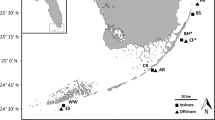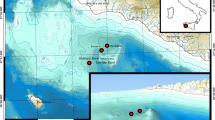Abstract
Prominent bands or lines were present on colonies of Millepora complanata on coral reefs at Barbados, West Indies. These bands appeared as regular, dark and light horizontal zones or stripes on vertically growing plates and blades making up the colonies. Bands are formed by wave-like undulations or currugations of the skeletal surface. The number of bands correlates with colony height and mean band width equals the mean annual vertical growth of measured colonies. Variation in annual growth and differences in growth rates of colonies between different reefs were determined from band width measurements. Bands provide a rapid and non-destructive means for measuring growth and ageing colonies of M. complanata.
Similar content being viewed by others
References
Boschma H (1948) The species problem in Millepora. Zool Verh Leiden 1:3–115
Buddemeier RW, Kinzie RA (1976) Coral growth. Oceanogr Mar Biol Ann Rev 14:183–225
Denny WW, Daniel TL, Koehl MAR (1985) Mechanical limits to size in wave swept organisms. Ecolog Monogr 55:69–102
Geister J (1975) Riffbau und geologische Entwicklungsgeschichte der Insel San Andres (Westliches Karibisches Meer, Kolumbien). Stuttgarter Beitr Naturk Ser B 15:203 pp
Greenberg J, Dunn JC (1985) Florida's underwater wilderness. Nat Geog Traveller 2:80–89
Hyman LH (1940) The invertebrates: protozoa through ctenophora. McGraw-Hill, New York London, p 726
Lough JM, Barnes DJ (1990) Intra-annual timing of density band formation of Porites coral from the Central Great Barrier Reef. J Exp Mar Biol Ecol 135:35–57
Moseley HM (1880) Report on certain hydroid, alcyonarian, and madreporarian corals procured during the volyage of H.M.S. Challenger in the years 1873–1876. Rept Sci Results Voyage Challenger, Zool 2:1–248
Scatterday JW (1974) Reefs and associated coral assemblages off Bonaire, Netherlands Antilles, and their bearing on Pleistocene and Recent reef models. Proc 2nd Int Coral Reef Symp 2:85–106
Stearn CW, Riding R (1973) Forms of the hydrozoan Millepora on a Recent coral reef. Lethaia 6:187–200
Stromgren T (1976) Skeleton growth of the hydrocoral Millepora complanata Lamarck in relation to light. Limnol Oceanogr 21:100–104
Tomascik T, Sander F (1987) Effects of eutrophication of reefbuilding corals. II. Structure of scleractinian coral communities on fringing reefs, Barbados, West Indies. Mar Biol 94:53–75
Weerdt WH de (1981) Transplantation experiments with Caribbean Millepora species (Hydrozoa, Coelenterata), including some ecological observations on growth forms. Bijdr Dierk 51:1–19
Witman JD (1988) Effects of predation by the fireworm Hermodice carunculata on Milleporid corals. Bull Mar Sci 42:446–458
Zottoli R (1978) Introduction to marine environments, 2nd edn. Mosby, St. Louis, p 252
Author information
Authors and Affiliations
Rights and permissions
About this article
Cite this article
Lewis, J.B. Banding, age and growth in the calcareous hydrozoan Millepora complanata Lamarck. Coral Reefs 9, 209–214 (1991). https://doi.org/10.1007/BF00290424
Accepted:
Issue Date:
DOI: https://doi.org/10.1007/BF00290424




